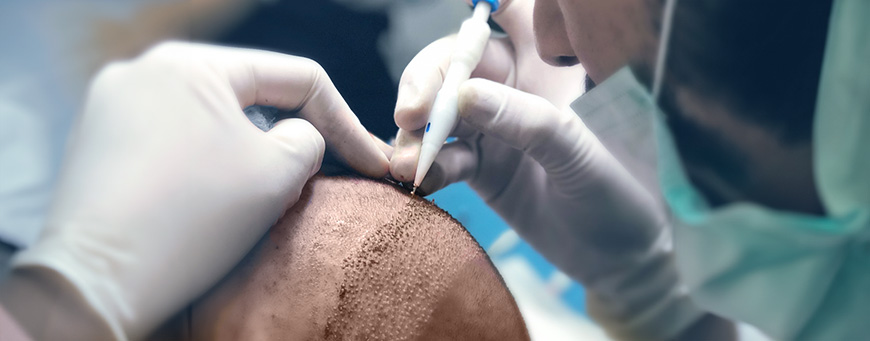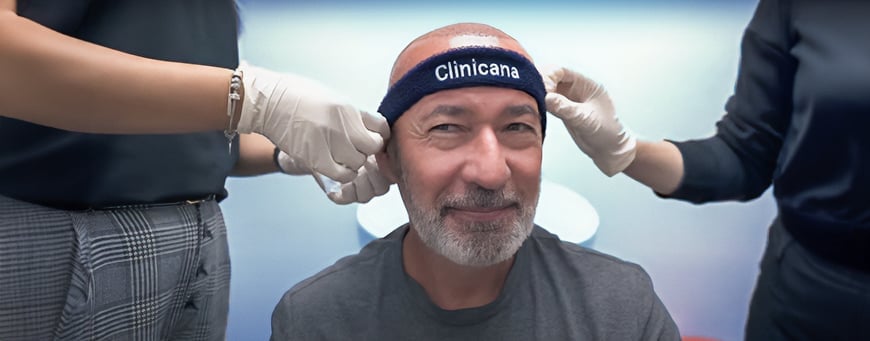FUE vs. DHI Hair Transplant in Turkey: Understanding the Differences & Choosing the Right Option
Many people look for Turkish clinics due to their expertise and affordability. But, when it comes to the actual hair transplant procedure, there are two main choices, Follicular Unit Extraction (FUE) and Direct Hair Implantation (DHI).
To be able to make the right decision, it is very important to understand the key differences between those two techniques. In this article, you will learn more about FUE and DHI techniques, and help you choose the best method for your needs and favored outcomes.
What is FUE hair transplant?
FUE hair transplant technique is a minimally invasive procedure that involves extracting hair follicles individually from donor areas (resistant to hair loss areas) and transplanting them to recipient areas ( thinning hair or baldness areas). It uses specialized tools to extract the follicles, leaving no scars unlike older methods that removed a strip of scalp and left noticeable scars.
How FUE hair transplant in Turkey is done?
The FUE hair transplant in Turkey includes many stages:
- Follicle Extraction or Removal: Local anesthesia is applied to the back of the head (donor area). Tiny punches of (0.7-0.8mm) are used to extract follicles one by one, leaving minimal scarring. This stage takes 2-2.5 hours, and the patient feels painless thanks to the anesthesia.
- Frontline Drawing: the natural hairline is designed after taking into account the forehead muscle and patient preferences. The doctor will make sure in this way to achieve a natural hair look.
- Channels Opening: The doctor will create Microscopic channels in the recipient area where the follicles will be implanted. This stage takes 40-90 minutes.
- Implantation stage: After the extraction, the follicles are carefully inserted into the opened channels. The doctor makes sure that they are in a natural direction and angle.
This stage can take many hours based on the number of grafts transplanted.
During the procedure, the patient feels painless thanks to local anesthesia.
FUE hair transplant benefits
FUE hair transplants offer many advantages for achieving a natural and minimal-invasive hair transplant procedure:
- Minimal scarring: Tiny extraction points leave virtually no marks, so it is considered ideal for short hairstyles.
- Faster recovery: thanks to FUE technique, the patient can return to his daily routines quicker than other methods.
- Natural-looking results: FUE can ensure precise control over follicle placement, which creates a realistic hairline.
- Suitable for thinning hair: FUE handles smaller grafts in an effective way, treating areas with less hair loss.
What is DHI hair transplant?
DHI hair transplant is a minimally invasive technique that combines creating channels and implanting extracted follicles in one step. During the procedure, the doctor uses a specialized pen-like tool called a Choi implanter. The Choi implanter can deposit individual follicles directly into the scalp, which minimizes handling and potentially leads to better growth.

How is DHI hair transplant in Turkey done?
Unlike other traditional techniques such as FUE, which involves separate steps for channel creation and follicle implantation, DHI hair transplant technique involves these two steps into one. Have a look how it is done:
- Follicle Loading: the extracted follicles are carefully placed inside the hollow needle tip of the Choi implanter.
- Implantation: the doctor uses the Choi implanter to create a tiny channel in the recipient area and simultaneously implants a preloaded follicle into the channel with precise control over angle and depth.
- Repeated Process: this process is repeated one follicle at a time. During the procedure, multiple Choi implanters with different needle sizes – depending on the hair unit – single, double, or triple -are used simultaneously for efficiency and faster completion time.
DHI hair transplant benefits
DHI hair transplant technique offers many advantages that ensure achieving a natural and efficient hair restoration:
- Minimal scarring: the direct implantation process minimizes trauma to the donor area, so it leaves virtually no visible scars.
- Faster recovery: the procedure is less invasive which leads to a shorter recovery period.
- Natural results: DHI allows precise follicle placement and angle, which results in a natural-looking hairline and excellent hair growth.
- Versatility: DHI technique can address various hair loss patterns in an effective way, offering a solution for individuals seeking natural and long-lasting hair growth.
FUE vs DHI hair transplant pros and cons
Both FUE and DHI are advanced hair transplant techniques offering natural-looking results with minimal scarring. However, they differ in their approach and have unique advantages and considerations. Let’s have a look at the pros and cons of each technique:
DHI vs FUE hair shaving
FUE hair transplant in Turkey requires shaving both donor and recipient areas for better access during implantation.
DHI technique only shaves the donor area, so it is ideal for individuals with long hair especially women.
DHI vs FUE recovery time
DHI hair transplant technique generally boasts a faster recovery time when compared to FUE technique. This difference is based on the way each technique can handle the recipient area.
FUE requires creating separate channels in the recipient area before implanting follicles, which in turn can prolong healing.
DHI combines channel creation and follicle implantation simultaneously into one step, which minimizes trauma and leads to a quicker recovery.
DHI vs FUE hair transplant success rate
While both FUE and DHI hair transplant techniques in Turkey boast high success rates, DHI can offer a slight advantage in terms of follicle survival for the following reasons:
Using the FUE method, the extracted follicles spend some time outside the scalp before implantation. This can slightly impact survival rates.
DHI technique combines extraction and implantation in one step. Thanks to this combination, DHI minimizes the period follicles spend outside the scalp -in saline solution- and boosts the possibility of a higher survival rate.
But, it’s important to know that success rates based on many factors beyond the technique itself, including the surgeon’s skill, patient health, and individual characteristics.
DHI vs FUE transplanted hair density
DHI and FUE hair transplants can achieve different levels of hair density.
In DHI method, Choi pen allows for better precision in follicle placement and angle control. This precision enables doctors to implant hair follicles closer together, which may result in higher hair density in the recipient area.
While in FUE technique, the process can offer good density results, the step of separate channel creation may limit the closeness of transplanted follicles, which may result in a slightly less dense appearance.
FUE vs DHI scarring
FUE method depends on sharp blades to create recipient channels, leaving tiny, scattered scars on the scalp. These scars are usually minimal and often invisible with short hairstyles, but for individuals who prefer to keep their hair long, they might be a concern.
DHI: in contrast, DHI technique employs the Choi pen that creates channels and implants follicles at the same time. This minimizes the need for extensive incisions, and results in virtually no visible scarring on the scalp.
DHI vs FUE hair transplant cost in Turkey
Generally, DHI hair transplant in Turkey is more expensive than FUE due to many factors:
- DHI is based on the Choi implanter, a specialized tool that adds to the overall cost.
- DHI often requires a larger medical team with good training and skills using the Choi pen, which in turn impacts the cost.
- DHI technique requires more precision and attention, so this also can contribute to a slightly higher cost.
But, it’s important to know that there are other factors that related to each patient can also determine the final cost:
- Number of grafts: more grafts typically means a higher cost, whatever the technique used.
- Donor Hair area characteristics: specific hair characteristics can change the total cost.
- Patient’s Hair Loss Condition: The extent of hair loss can impact the cost.
So, it is very crucial to contact qualified professionals to compare quotes from reputable clinics in Turkey If you want to find the best value for your specific needs and budget.
Resources:
https://www.healthline.com/health/dhi-hair-transplant#side-effects-and-precautions
https://www.clinicana.com/blog/dhi-hair-transplant/
https://www.clinicana.com/hair-transplant/fue-hair-transplant-turkey/
https://www.clinicana.com/blog/hair-transplant-main/

A hair transplant procedure can be a transformative experience. But to ensure your newly implanted follicles thrive, proper aftercare is very essential. This article equips you with key hair transplant recovery tips or post-operative instructions to minimize discomfort, optimize healing, and pave the way for a successful hair transplant journey for you. Hair transplant recovery […]

Dreaming of a full head of hair? Hair transplants are gaining traction, particularly in Turkey as clinics there are characterized by budget-friendly options and skilled surgeons. But, with so many clinics, the way of choosing the right one can be overwhelming. This article will help you find one of those top 10 hair transplant clinics […]

Finding the best hair transplant clinic in Istanbul is a crucial decision. In this article, we will look at some important factors to help you make an informed decision to ensure a successful surgery. How to choose the best hair transplant clinic in Istanbul? Istanbul has emerged as a sought – after destination for hair […]






